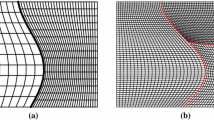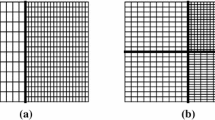Abstract
In this article we develop a numerical scheme to deal with interfaces between touching numerical grids when solving the second-order wave equation. We show that it is possible to implement an interface scheme of “penalty” type for the second-order wave equation, similar to the ones used for first-order hyperbolic and parabolic equations, and the second-order scheme used by Mattsson et al. 2008. These schemes, known as SAT schemes for finite difference approximations and penalties for spectral ones, and ours share similar properties but in our case one needs to pass at the interface a smaller amount of data than previously known schemes. This is important for multi-block parallelizations in several dimensions, for it implies that one obtains the same solution quality while sharing among different computational grids only a fraction of the data one would need for a comparable (in accuracy) SAT or Mattsson et al.’s scheme. The semi-discrete approximation used here preserves the norm and uses standard finite-difference operators satisfying summation by parts. For the time integrator we use a semi-implicit IMEX Runge–Kutta method. This is crucial, since the explicit Runge–Kutta method would be impractical given the severe restrictions that arise from the stiff parts of the equations.















Similar content being viewed by others
Notes
Here we aim at an accuracy of about one part in \(10^{3}\) for \(10\) periods. Enough to keep the phase without appreciable error for about \(10\) crossing times.
This is of course true in the case of scalar quantities. In the case we were dealing with systems of wave equations applied to tensor quantities, some coordinate transformations are unavoidable at interfaces.
References
Mattsson, K., Ham, F., Iaccarino, G.: Stable and accurate wave-propagation in discontinuous media. J. Comput. Phys. 227, 8753–8767 (2008)
Carpenter, M.H., Nordström, J., Gottlieb, D.: A stable and conservative interface treatment of arbitrary spatial accuracy. J. Comput. Phys. 148(2), 341–365 (1999)
Reula, O. A.: Numerical treatment of interfaces in Quantum Mechanics. ArXiv e-prints, (2011) http://adsabs.harvard.edu/abs/2011arXiv1103.5448R
Kreiss, H., Ortiz, O.: Some Mathematical and Numerical Questions Connected with First and Second Order Time-Dependent Systems of Partial Differential Equations. Lectures Notes in Physics, vol. 604 (2002)
Kreiss, H.-O., Scherer, G.: On the Existence of Energy Estimates for Difference Approximations for Hyperbolic Systems. Tech. Rep. Dept. of Scientific Computing, Uppsala University (1977)
Summation by parts for finite difference approximations for \(d/dx\). J. Comput. Phys. 110(1), 47–67 (1994). doi:10.1006/jcph.1994.1005. ISSN 0021–9991
Gustafsson, B., Kreiss, H.-O., Oliger, J.: Time Dependent Problems and Difference Methods. Wiley, New York (1995)
Mattsson, K., Nordström, J.: Summation by parts operators for finite difference approximations of second derivatives. J. Comput. Phys. 199, 503–540 (2004)
Mattsson, K., Parisi, F.: Stable and accurate second-order formulation of the shifted wave equation. Commun. Comput. Phys. 7, 103–137 (2010)
Ascher, U.M., Ruuth, S.J., Spiteri, R.J.: Implicit–explicit Runge–Kutta methods for time-dependent partial differential equations. Appl. Numer. Math. 25(2–3), 151–167 (1997)
Pareschi, L., Russo, G.: Implicit–explicit Runge–Kutta schemes and applications to hyperbolic systems with relaxation. J. Sci. Comput. 25, 129–155 (2005)
Lehner, L., Reula, O., Tiglio, M.: Multi-block simulations in general relativity: high order discretizations, numerical stability, and applications. Class. Quant. Grav. 22, 5283–5322 (2005). doi:10.1088/0264-9381/22/24/006
Diener, P., Dorband, E.N., Schnetter, E., Tiglio, M.: Optimized high-order derivative and dissipation operators satisfying summation by parts, and applications in three-dimensional multi-block evolutions. J. Sci. Comput. 32, 109–145 (2007)
Kreiss, H., Oliger, J.: Methods for the Approximate Solution of Time Dependent Problems. GARP Publication Series No. 10. WMO, ICSU, Geneva (1973)
Tiglio, M., Lehner, L., Neilsen, D.: 3D simulations of Einstein’s equations: symmetric hyperbolicity, live gauges, and dynamic control of the constraints. Phys. Rev. D 70(10), 104018 (2004). doi:10.1103/PhysRevD.70.104018
Calabrese, G., Pullin, J., Sarbach, O., Tiglio, M.: Stability properties of a formulation of Einstein’s equations. Phys. Rev. D 66(6), 064011 (2002). doi:10.1103/PhysRevD.66.064011
Alcubierre, M., Allen, G., Bona, C., Fiske, D., Goodale, T., Guzmán, F.S., Hawke, I., Hawley, S.H., Husa, S., Koppitz, M., Lechner, C., Pollney, D., Rideout, D., Salgado, M., Schnetter, E., Seidel, E., Shinkai, H.-A., Shoemaker, D., Szilágyi, B., Takahashi, R., Winicour, J.: Towards standard testbeds for numerical relativity. Class. Quantum Gravity 21, 589–613 (2004). doi:10.1088/0264-9381/21/2/019
Szilágyi, B., Kreiss, H.-O., Winicour, J.: Modeling the black hole excision problem. Phys. Rev. D 71(10), 104035 (2005). doi:10.1103/PhysRevD.71.104035
Babiuc, M.C., Szilágyi, B., Winicour, J.: Harmonic initial-boundary evolution in general relativity. Phys. Rev. D 73(6), 064017 (2006). doi:10.1103/PhysRevD.73.064017
Acknowledgments
We thank Luis Lehner and Manuel Tiglio for discussions, and SeCyT-UNC, CONICET, FONCyT and the Partner Group grant of the Max Planck Institute for Gravitational Physics (Albert Einstein Institute) for financial support. O.R. thanks Perimeter Institute for hospitality, where part of this research was carried out.
Author information
Authors and Affiliations
Corresponding author
Rights and permissions
About this article
Cite this article
Parisi, F., Cécere, M., Iriondo, M. et al. Numerical Treatment of Interfaces for Second-Order Wave Equations. J Sci Comput 62, 875–897 (2015). https://doi.org/10.1007/s10915-014-9880-7
Received:
Revised:
Accepted:
Published:
Issue Date:
DOI: https://doi.org/10.1007/s10915-014-9880-7




